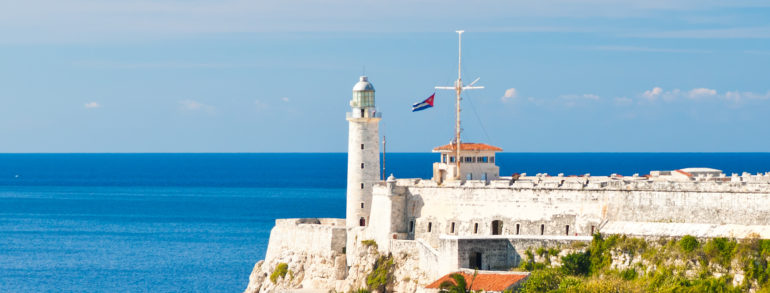Old Havana - Castles and Fortresses
Castillo del Morro - Cabaña Historical Military Park
Whoever is master of this hill will be master of Havana was the assessment made of the location of the Morro - La Cabaña fortress complex more than 400 years ago by Antonelli, the engineer who designed the defense system of Colonial Havana.
The English, following Antonelli's appraisal to the letter, took Morro Castle by storm in 1762, and proceeded to occupy Havana, and when the Spanish regained possession of the city they ensured that would never happen again by building the most powerful fortress in the Americas: San Carlos and San Severino de la Cabaiia, whose construction was concluded toward the end of the 1700s.
This fortress, together with Morro Castle (Castillo de los Tres Reyes del Morro), make up the Morro - Cabaña Historical Military Park, the most extensive museum in the country.
Morro Castle is, in itself, a museum piece revealing the solutions of renaissance architecture applied to military strategy.
Inside the castle, there are two theme rooms on the history of navigation in Havana Harbor, which contain objects salvaged from a ship that went down at the harbor entrance in the 18th century.
There are also temporary exhibits on various themes.
Nightly Gun Shot (Cannon Ceremony) USD$5 - Yep "ONE" shot!
Fortaleza San Carlos and San Severino de La Cabaña
Fortaleza de la Cabaña was built 1763-1774. Fronting the harbor is a high wall; the ditch on the landward side, 12m deep, has a drawbridge to the main entrance. Inside are Los Fosos de los Laureles where political prisoners were shot during the Cuban fight for independence. Every night the cannons are fired in an historical ceremony recalling the closing of the city walls in the 17th century to protect it from pirates; this starts at 2045 so that the walls are closed at 2100.
Open to visitors 0830-2200, USD$3. There are two museums here, one about Che Guevara and another about fortresses with pictures and models, some old weapons and a replica of a large catapult and battering ram. Access as for Castillo del Morro or via Casablanca.
The fortress of San Carlos and San Severino de La Cabaña holds the most important collection of antique weapons in the country: a full-scale medieval catapult and battering ram; double-curved swords of Southeast Asia; the Indian Katar, a fearsome three-bladed dagger; the venerable katanas of the samurai; ornate Arabian rifles; and an entire battery of cannon cast in Seville In the 18th century. When Havana was a walled city, every night at 9:00 p.m. La Cabaña fortress would fire one of its cannons to announce the closing of the doors, a tradition preserved by the people of Havana to this very day. The impressive view from Morro Castle or La Cabaña takes in the entire harbor and the skyline of the city.
Collections: World history through the development of weapons; Archaeology; Military architecture; History of Cuba; History of navigation in Cuba; Diverse temporary exhibits.
Castillo de la Punta
Castillo de la Punta was built at the end of the 16th century. A squat building with 2m thick walls, open daily. Entrance (free) through gap in makeshift fencing, custodian with dogs shows you around. Opposite the fortress, across the Malecón, is the monument to Máximo Gómez, the independence leader.
Castillo de la Real Fuerza
Castillo de la Real Fuerza ,Cuba's oldest building and the second oldest fort in the New World, was first built in 1558, after the city had been sacked by buccaneers, and rebuilt in 1582. It is a low, long building with a picturesque tower from which there is a grand view. Inside the castle is a museum with armor and ceramics, open daily, 0830-1830, USD$1. Art exhibitions downstairs. Small shop and cafeteria upstairs.
This museum is located in the Castillo de la Real Fuerza, the oldest colonial fortress in the Americas (1577) built, according to the military engineering practice of the times, with massive bulwarks, studded with cannon, bombards and culverins (many of them still in place) and a moat to protect it from the enemy.
The fortress was the official residence of the Captains General until 1791. Atop the "Tribute Tower," former belfry and look-out point, we find a world-famous statue that is the symbol of Havana, La Giraldilla, a graceful female figure representing Doña Isabel de Bobadilla, the first woman governor of Cuba. The figure was cast in bronze and served as a wind vane for ships entering the harbor.
After a long history as a fortress, Governor's residence, library and archive, in 1977, on its 400th anniversary, it was declared a National Monument and now houses a specialized Cuban ceramics collection.
Collections: Amelia Pelaez; Wilfredo Lam; Rene Portocarrero; Rodriguez de Cruz; and many representatives of the present generation of Cuban ceramics artists.
Address: Calle Tacon e/ Obispo y O'Reilly, La Habana Vieja
Open: Tuesday to Saturday: 11:30 to 17:30, Sundays: 09:00 to 12:00, Closed Mondays
There are two other old forts in Havana: Atarès, finished in 1763, on a hill overlooking the southwest end of the harbor; and El Prìncipe, on a hill at the far end of Av Independencia (Av Rancho Boyeros), built 1774-1794, now the city gaol. Finest view in Havana from this hill.

